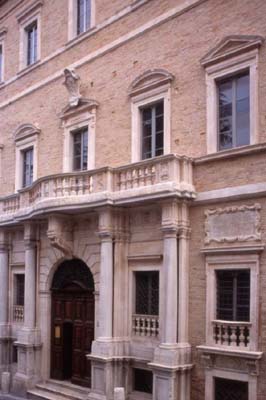Palazzo Compagnoni Marefoschi, Macerata on:
[Wikipedia]
[Google]
[Amazon]
 The Palazzo Compagnoni Marefoschi is a
The Palazzo Compagnoni Marefoschi is a
Comune of Macerata
entry on palace. The palace was the birthplace of cardinal
 The Palazzo Compagnoni Marefoschi is a
The Palazzo Compagnoni Marefoschi is a Baroque
The Baroque ( , , ) is a Western Style (visual arts), style of Baroque architecture, architecture, Baroque music, music, Baroque dance, dance, Baroque painting, painting, Baroque sculpture, sculpture, poetry, and other arts that flourished from ...
-style aristocratic urban palace located on Via don Minzoni 11 in the center Macerata
Macerata () is a city and ''comune'' in central Italy, the county seat of the province of Macerata in the Marche region. It has a population of about 41,564.
History
The historical city centre is on a hill between the Chienti and Potenza (ri ...
, region of the Marche, Italy. It rises diagonal to the Palazzo Buonaccorsi
The Palazzo Buonaccorsi is an 18th-century aristocratic palace, now the civic museum of the town, located on Via Don Minzoni 24 in the historic center of Macerata, region of Marche, Italy.
Description
The palace was erected on a site with some h ...
.
History
Documents recall that the Compagnoni family by 1138 were inhabiting this site. By 1211, they had extended their holdings in this quarter of the city. The various buildings at this site were built over various centuries. In 1736, the branch of the family Compagnoni delle Lune built their own palace, commissioned from the architectFrancesco Vici
Francesco, the Italian (and original) version of the personal name "Francis", is one of the most common given name among males in Italy. Notable persons with that name include:
People with the given name Francesco
* Francesco I (disambiguation) ...
. A few decades later, the Compagnoni Marefoschi (arising from the Compagnoni delle Stelle) erected this present adjacent palace in the 18th-century.
From 1755 to 1771, the brothers Mario and Camillo Compagnoni Marefoschi, commissioned from Luigi Vanvitelli
Luigi Vanvitelli (; 12 May 1700 – 1 March 1773), known in Dutch as (), was an Italian architect and painter. The most prominent 18th-century architect of Italy, he practised a sober classicising academic Late Baroque style that made an ea ...
a major refurbishment, leading to the late-baroque or Rococo
Rococo, less commonly Roccoco ( , ; or ), also known as Late Baroque, is an exceptionally ornamental and dramatic style of architecture, art and decoration which combines asymmetry, scrolling curves, gilding, white and pastel colours, sculpte ...
facade we see presently. Along the entrance stairway are numerous ancient Roman inscriptions derived from Hadrian's Villa
Hadrian's Villa (; ) is a UNESCO World Heritage Site comprising the ruins and archaeological remains of a large Roman villa, villa complex built around AD 120 by Roman emperor Hadrian near Tivoli, Italy, Tivoli outside Rome.
It is the most impos ...
at Tivoli.entry on palace. The palace was the birthplace of cardinal
Mario Compagnoni Marefoschi
Mario Compagnoni Marefoschi (10 September 1714 – 23 December 1780) was a cardinal of the Roman Catholic Church.
He was born in the Palazzo Compagnoni Marefoschi in Macerata, Italy. Pope Clement XIV made him a cardinal ''in pectore'' on 29 Ja ...
who spearheaded the suppression of the Jesuit order. In 1772, the palace hosted the marriage celebration for Louise of Stolberg-Gedern
Princess Louise Maximiliane Caroline Emanuel of Stolberg-Gedern (20 September 1752 – 29 January 1824) was the wife of Charles Edward Stuart, the Jacobite claimant to the English and Scottish thrones. The unhappy marriage led her to request f ...
and Charles Edward Stuart
Charles Edward Louis John Sylvester Maria Casimir Stuart (31 December 1720 – 30 January 1788) was the elder son of James Francis Edward Stuart, making him the grandson of James VII and II, and the Stuart claimant to the thrones of England, ...
, Count of Albany and pretender to the throne of England. The palace still houses descendants of the Compagnoni, and also is home to a School of Paralegal Training (Scuola di Specializzazione per le Professioni Legali).

References
Bibliography
*Adele Piergallini, Umberto Santori Compagnoni Marefoschi, Palazzo Compagnoni Marefoschi di Macerata, vol. 1 (collana "La famiglia Compagnoni Marefoschi: i Palazzi e la storia"), 2011. {{DEFAULTSORT:Compagnoni Marefoschi Buildings and structures in Macerata Baroque architecture in Marche Palaces in Marche Luigi Vanvitelli buildings